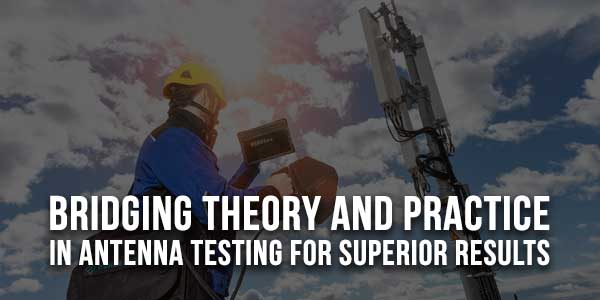
In the rapidly evolving field of telecommunications, the performance of antennas plays a crucial role in ensuring reliable and efficient communication. Bridging the gap between theoretical concepts and practical implementation in antenna testing is essential for achieving superior results. This article explores the critical aspects of antenna testing, providing a comprehensive overview of both theoretical foundations and practical applications. By understanding and applying these principles, engineers, and researchers can enhance the performance, accuracy, and reliability of antenna systems in various applications.
Table of Contents
The Purpose Of Antenna Testing:
The primary purpose of antenna testing is to evaluate and refine the performance of an antenna system. This process ensures that antennas meet specified standards and function optimally within their intended environments. By conducting thorough tests, engineers can identify and address issues such as signal interference, impedance mismatches, and radiation pattern deficiencies. Ultimately, the goal of antenna testing is to improve signal quality, maximize coverage, and ensure that communication systems operate reliably. Achieving superior antenna performance is vital for applications ranging from mobile networks and satellite communications to radar systems and wireless devices.
Theoretical Foundations Of Antenna Testing:
The performance of an antenna is determined by its ability to radiate and receive electromagnetic waves. This behaviour can be predicted through mathematical models based on fundamental concepts such as Maxwell’s equations, radiation patterns, gain, directivity, polarization, impedance matching, and efficiency. These theoretical foundations form the basis for designing and testing antennas for optimal performance. In addition, understanding the underlying principles allows engineers to troubleshoot and improve antenna designs for better results.
Practical Considerations In Antenna Testing:
While theoretical knowledge is crucial, practical considerations are equally important in antenna testing. Antennas operate in real-world environments that can introduce various challenges and limitations. For instance, factors such as surrounding objects, weather conditions, interference, and noise can affect the performance of an antenna. Therefore, practical testing involves simulating these real-world scenarios to evaluate the antenna’s performance accurately. This step is essential in identifying and addressing any potential issues that may impact the overall efficiency of the system.
Importance Of Accurate Measurements:
Accurate measurement is crucial for evaluating and validating the performance of an antenna. By using specialized equipment such as network analyzers, spectrum analyzers, and anechoic chambers, engineers can obtain precise measurements of key parameters such as gain, directivity, and radiation patterns. These measurements provide valuable insights into the antenna’s behavior and allow for comparison with theoretical predictions. Additionally, accurate measurements are necessary for compliance testing to ensure that antennas meet regulatory standards.
Ensuring Accuracy In Antenna Testing:
To ensure accuracy in antenna testing, a systematic approach is necessary, involving meticulously calibrated equipment, controlled testing environments, and robust testing methodologies. Calibration of testing instruments such as network analyzers and spectrum analyzers is fundamental to eliminating measurement errors. The use of anechoic chambers, which absorb reflections and simulate free-space conditions, is crucial for isolating the antenna from external interferences and noise. Additionally, standardized testing procedures, following industry guidelines and frameworks, help maintain consistency and repeatability of results. Proper documentation and analysis of test data further enhance the reliability of measurements, enabling engineers to make informed decisions about antenna performance and necessary improvements.
Advancements In Antenna Testing:
With the continuous evolution of wireless technology, antenna testing has also advanced significantly. New methods and techniques such as near-field measurements, far-field measurements, and compact range testing have been developed to improve the accuracy and efficiency of antenna evaluation. Moreover, advancements in computer simulations and modeling software have made it easier to analyze and optimize antenna designs before physical testing. These advancements have greatly enhanced the speed and accuracy of antenna testing, allowing for faster development and deployment of new antenna systems.

Challenges In Antenna Testing:
Despite numerous advancements, antenna testing presents several challenges that engineers and researchers must navigate. One of the primary difficulties is replicating real-world conditions in a controlled testing environment. Factors such as multipath propagation, signal reflections from nearby structures, and environmental variables like temperature and humidity can significantly influence test results. Additionally, the increasing complexity of modern antenna systems, which often combine multiple frequency bands and support various communication standards, adds another layer of difficulty. Addressing these challenges requires a combination of innovative testing techniques, sophisticated simulation tools, and meticulous attention to detail to ensure accurate and reliable outcomes.
Troubleshooting Antenna Testing Problems:
When facing challenges in antenna testing, a systematic troubleshooting approach is essential to identify and resolve issues effectively. Start by verifying the calibration of all testing equipment to ensure accurate measurements. Check for external sources of interference that could skew results, such as nearby electronic devices or reflective surfaces. Carefully review the test setup to confirm that the antenna is positioned correctly and that all connections are stable and secure. It’s also important to consider environmental factors like temperature and humidity, which can impact performance. By examining each element of the testing process, engineers can pinpoint the root causes of problems and implement the necessary adjustments to achieve accurate and reliable results.
Future Trends In Antenna Testing:
As technology continues to progress, the field of antenna testing is poised for several transformative trends. One such trend is the integration of artificial intelligence (AI) and machine learning (ML) into testing processes. By leveraging AI and ML algorithms, engineers can analyze vast amounts of data more efficiently, uncovering patterns and insights that would be difficult to detect manually. Additionally, the adoption of 5G technology introduces new testing challenges and opportunities, as antennas must be evaluated for higher frequencies and more complex beamforming techniques. Another key trend is the development of automated and remote testing systems, which allow for continuous monitoring and real-time analysis, reducing the need for manual intervention and enabling more consistent and accurate results. These advancements promise to further enhance the precision, efficiency, and adaptability of antenna testing in the coming years.
Conclusion:
Bridging theory and practice in antenna testing is crucial for achieving superior results. By understanding the theoretical foundations and considering practical considerations, engineers can design, test, and optimize antennas for optimal performance. Accurate measurements and advancements in testing methods further improve the accuracy and efficiency of antenna testing, leading to reliable and efficient communication systems. As technology continues to advance, it is essential to stay updated on the latest developments in antenna testing to ensure the best possible performance for wireless communication.

 About the Author:
About the Author:












Be the first to write a comment.